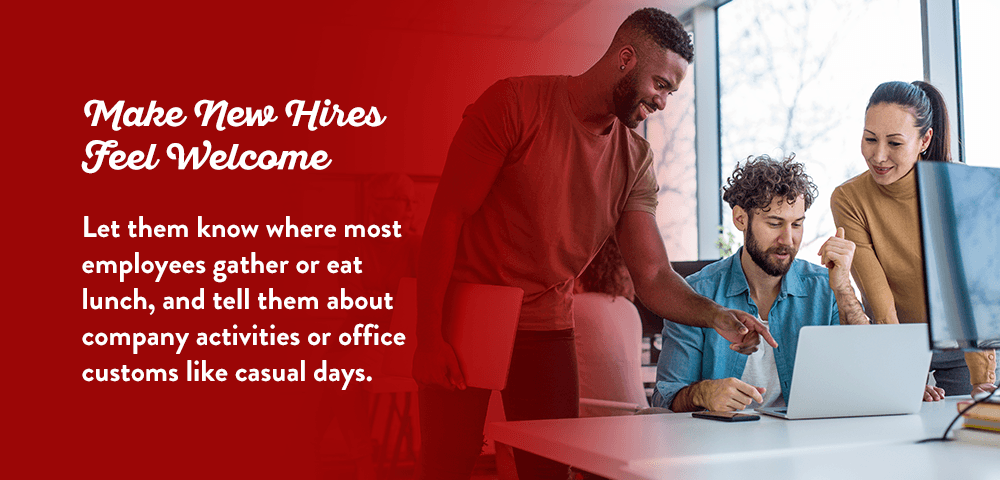
Understanding the importance of the onboarding induction process can significantly benefit your company. Employee orientation helps new employees feel confident and motivated at work. Treat new employees to a catered corporate lunch and follow some employee orientation best practices to help them have a successful first day.
What Is Employee Onboarding?
Employee onboarding is the process that occurs when a new hire starts working at a company. During onboarding, new employees may fill out paperwork, meet current employees, tour the office, learn procedures and acclimate to the company.
Employee onboarding allows new hires to adjust to their new role within the company. It’s a great opportunity for companies to create a positive first impression and make employees feel welcome.
Why Employee Onboarding Is Important
Employee onboarding is important because it helps employees adjust to the company and their role within it. Onboarding introduces employees to company philosophies, the company’s purpose and their responsibilities as a company employee. A well-planned and implemented onboarding process can engage and motivate employees, making them feel like a valued part of the team from the beginning. Employee onboarding has the following benefits:
- Increased employee engagement
- Higher productivity
- More knowledgeable employees
- Increased job satisfaction
- Reduced employee turnover
According to the United States Bureau of Labor Statistics (BLS), the number of employees who quit their jobs increased by 370,000 between October 2021 and November 2021. In total, 4.5 million employees quit their jobs in November 2021, which is the highest number of recorded quits since December 2000. To increase employee retention rates, companies should consider improving their employee onboarding process.
Most Common Mistakes During the Onboarding Process
Onboarding is more than filling out paperwork and handing out an employee handbook. It’s an important process that requires adequate planning. If you’re wondering what not to do in new hire orientation, avoid the following common mistakes:
1. Neglecting a Structured Process
New employees will form some of their first impressions of the company during the onboarding process. If the process is unorganized, a new hire will most likely assume that the company is disorganized. Additionally, new employees may feel neglected and unsupported if people within the company fail to talk to them or provide training. Simply giving a new hire the employee handbook to read is not enough.
Planning and implementing a structured onboarding process can convey that the company is organized and well-operated. It will help new employees feel supported and excited to work for the company.
2. Failing to Give New Employees a Tour
Failing to greet new hires and give them a tour can make them feel unwelcome. It’s important to make new employees feel welcome and connected to other team members. Choose one or two friendly employees to greet new hires, show them around the office and provide useful information. They can share information about nearby lunch spots, parking, team building activities and more.
Greeting new employees with a friendly smile and a helpful tour can help them feel like they are a part of the team. Shed a positive light on your company culture by making your new employees feel welcome.
3. Overwhelming New Employees With New Information
Overwhelming new employees with information is one of the most common new hire orientation mistakes. Learning takes time, and too much information in one day can overwhelm new employees. Provide new information and training resources at a reasonable pace to allow new hires time to absorb the information.
Retaining a ton of information in one day is almost impossible, so allow new employees several days to gather new information and assimilate it.
4. Flooding New Employees With Paperwork
Paperwork such as contact forms, benefits and tax information is necessary. However, you should avoid overwhelming new employees with paperwork. They should spend most of their orientation day getting to know the company and just a small portion on filling out paperwork.
Utilize technology and other resources to help employees complete important paperwork before the onboarding process so they can spend their first day acclimating to the company.
5. Failing to Give Employees Tasks to Do
While the first few days on the job may be dedicated to learning and adjusting, make sure new employees also have some responsibilities within the first several days. Give new employees tasks to complete so they feel useful and included. New employees are excited to use their abilities, so start giving them work to do once they feel comfortable.
 Employee Orientation Best Practices
Employee Orientation Best Practices
Employee orientation is important for maintaining employee morale and retention. Improve your employee onboarding experience with the following best practices:
1. Make New Hires Feel Welcome
Greet new employees as soon as they enter the building. Meet them with a friendly smile and make them feel welcome. Set their desk up, offer them a coffee or invite them to a catered company lunch. Choose someone to show them around the office and introduce them to team members so they feel more comfortable. Giving new hires time to adjust to the office and meet friendly faces can ease first-day anxiety.
It’s also important to explain company culture to new employees. Let them know where most employees gather or eat lunch, and tell them about company activities or office customs like casual days.
2. Provide Clear Rules and Procedures
Employees who clearly understand company expectations, proper procedures and their own responsibilities will feel more confident going into their role. Provide clear instructions and rules about how you expect employees to do their jobs. Create an employee handbook that new hires can reference when they have questions, and be sure to include the following information and procedures:
- Job information
- Lingo, acronyms or important terms
- Department information and phone numbers
- Information about meetings
- Protocols for taking messages
- Phone-use rules and protocols
- IT troubleshooting tips
- IT department contact information
3. Engage Employees
Engage employees with the company by providing support and clear goals. Assign a staff member to answer any questions they may have and help them acclimate to the office. Establish goals for new employees and provide them with work tasks once they start to feel comfortable in their role. Providing clear goals to achieve will help employees feel engaged and motivated.
Make New Hires Feel Special With Corporate Lunch Catering
Make your new employees feel special and welcome on their first day with delicious corporate lunch catering. Treat a group of new hires to a special lunch or plan a corporate lunch for all current and new employees to get to know each other. Order delicious, individually packaged meals delivered to your office for an easy and delicious corporate lunch.
Choose Apple Spice Catering
Successful employee onboarding can significantly improve employee retention rates, motivate employees and increase productivity. Make your new employees feel comfortable in the office with a welcoming catered lunch.
Apple Spice Catering will deliver fresh, individually labeled boxed lunches to your office. As corporate catering experts for over 30 years, we are dedicated to providing quality meals for corporate events. We can make your next corporate event easy with online ordering, fast delivery and guaranteed freshness. Order online for your next event and treat your employees to a catered lunch.



 1. Encourage Breaks
1. Encourage Breaks Order Apple Spice Corporate Catering
Order Apple Spice Corporate Catering